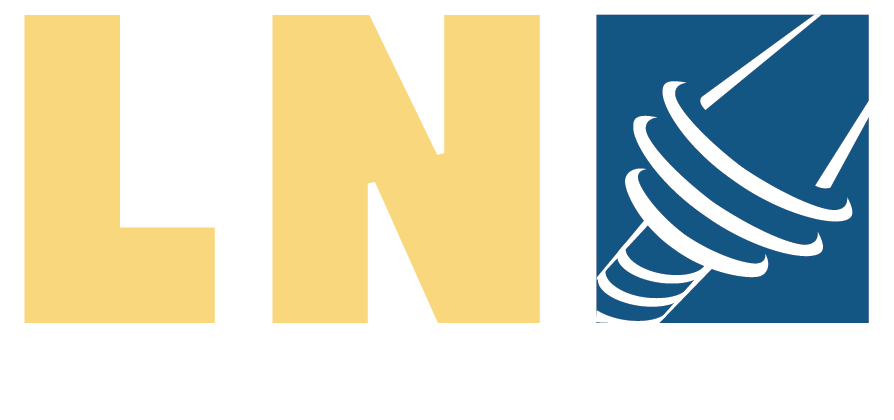Angle Heads and Speeders
Clearance
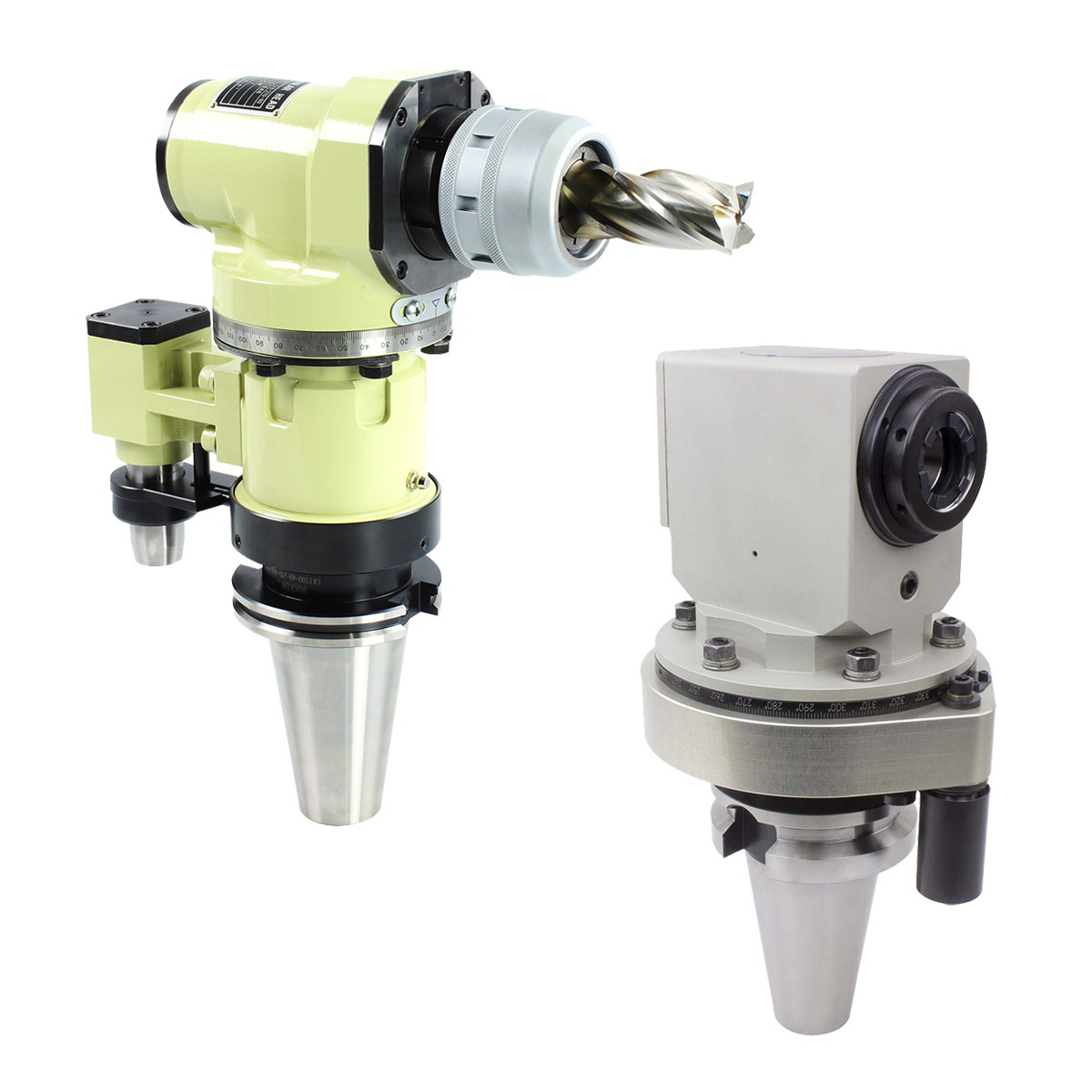
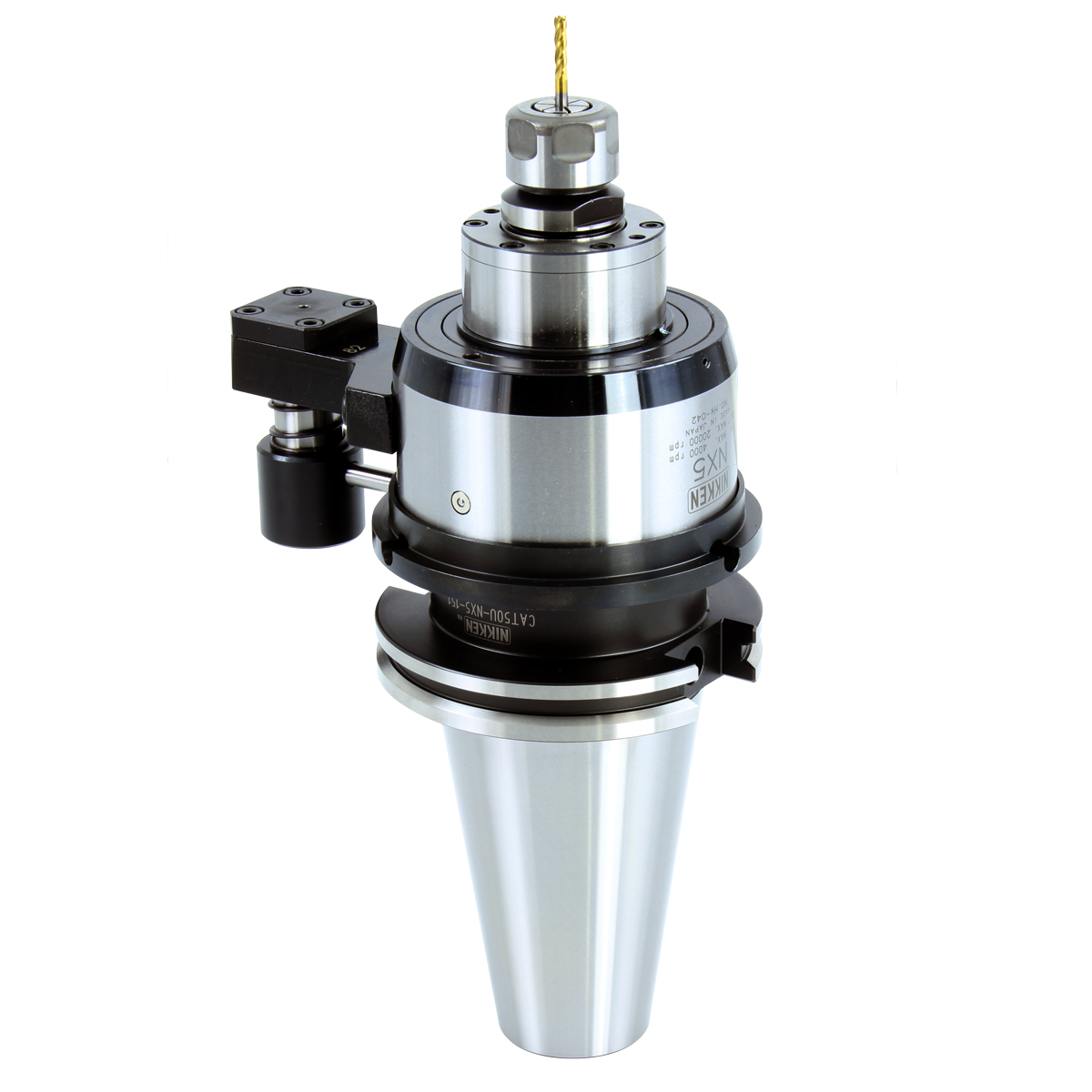
Angle Heads – Expand Capabilities of Machining Centers
Angle heads are specialized tooling attachments used in machining operations, particularly in milling and drilling processes. These attachments are designed to allow the cutting tool to approach the workpiece at various angles. Angle heads can rotate or tilt to achieve the desired cutting orientation, enabling machining operations in tight spaces, complex geometries, or difficult-to-reach areas of the workpiece.
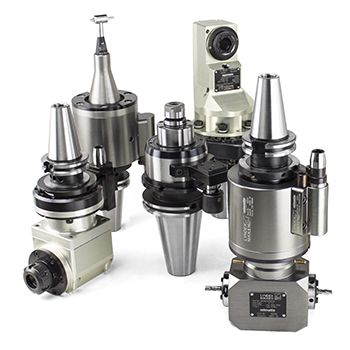
Here are some key functions and capabilities of angle heads:
Multi-Axis Machining: Angle heads enable multi-axis machining by allowing the cutting tool to approach the workpiece from different angles along multiple axes. This capability is particularly useful for complex parts with intricate features that require machining from various directions.
Accessing Tight Spaces: Angle heads can reach into confined or obstructed areas of the workpiece that would be inaccessible with traditional tooling setups. This ability is advantageous for machining internal features, cavities, or intricate contours where clearance is limited.
Optimizing Tool Engagement: By adjusting the angle of the cutting tool, angle heads can optimize tool engagement with the workpiece, ensuring efficient material removal and minimizing tool wear. This is especially beneficial for achieving optimal cutting conditions and surface finish in challenging machining applications.
Increasing Flexibility: Angle heads enhance the flexibility of machining operations by providing versatility in tool orientation. Machinists can easily adjust the angle of the cutting tool to accommodate different machining requirements, geometries, or part orientations without the need for extensive repositioning of the workpiece or machine setup.
Improving Productivity: Angle heads can improve productivity by reducing setup time, minimizing tool changes, and increasing machining efficiency. They enable more efficient use of machine tool capabilities and allow for simultaneous machining of multiple features or surfaces, leading to faster cycle times and higher throughput.
Enhancing Accuracy: Multiple operations can be done without re-fixturing the part.
Customization and Adaptability: Angle heads are available in a variety of configurations, sizes, and orientations to suit different machining applications and machine tool setups.
Overall, angle heads play a crucial role in expanding the capabilities of machining centers and improving the efficiency, flexibility, and accuracy of machining processes in manufacturing operations. They enable machinists to overcome spatial constraints, access difficult-to-reach areas, and perform complex machining operations with precision and ease.
Quality angle heads are equipped with hardened and ground gears and collet shafts. Units are also fitted with high-precision angular contact bearings, assuring improved rigidity and accuracy. Compact designs will maintain accurate spindle and tool centerline alignment while minimizing tool overhang - accuracy is maintained throughout the machining process from plane to plane. Key features that ensure the rigidity and accuracy of an angle head include:
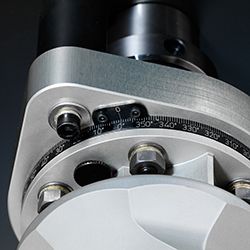 Vernier Scales and Positioning Rings - Vernier scales help to orient the cutting tool location (0 - 360°).
Vernier Scales and Positioning Rings - Vernier scales help to orient the cutting tool location (0 - 360°).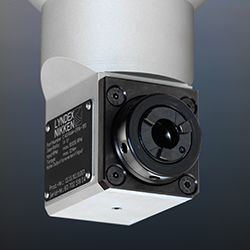 Recessed Collet Seat - With the collet seat recessed into the body of the angle head, rigidity is optimized while maintaining a compact design.
Recessed Collet Seat - With the collet seat recessed into the body of the angle head, rigidity is optimized while maintaining a compact design.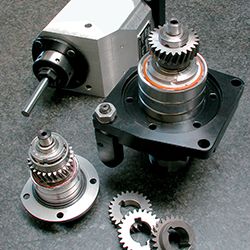 High Precision Assembly - Angle heads assembled with high precision, P4 quality spindle bearings that are stabilized for high speeds up to 15,000 rpm and high torques up to 110.634 lbs-ft.. The spiral beveled gears allow for high rigidity and smooth machining operations.
High Precision Assembly - Angle heads assembled with high precision, P4 quality spindle bearings that are stabilized for high speeds up to 15,000 rpm and high torques up to 110.634 lbs-ft.. The spiral beveled gears allow for high rigidity and smooth machining operations.
Right Angle Heads – Machining Perpendicular to the Spindles Axis
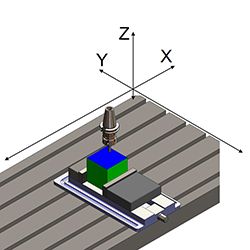
Right angle heads are tools used to perform machining operations perpendicular to the spindle axis (Z axis). All vertical machines commonly work in the surface/plane noted by the BLUE section in the illustration below (Z axis is perpendicular to the work plane). In order to machine surfaces/planes denoted by GREEN in the illustration to the right, without unchucking and rotating the part, one possible solution is to use an angle head.
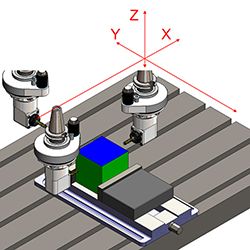
Angle heads can be set to access 360 degrees around a fixed workpiece. So, if you are spending too much time doing multiple set-ups and/or having part inaccuracies due to having to do multiple set-ups, using angle heads may be a better solution for your application.
The benefits of using right angle heads include:
Setup Time Reduction - Eliminate reconfiguring the parts machining plane results in less set-ups and thereby reducing time.
Cycle Time Reduction - Angle heads help integrate different machining processes reducing cycle time.
Increased Part Accuracy - Less handling of the workpiece reduces inaccuracies associated with multiple set ups, including less scrap.
Ability to Access Hard to Reach Features - Features inside of tubes, castings and forgings may only be accessed by using a right angle head.
Phil Linscheid, Director of Manufacturing, at Hamilton Company manufactures medical products and other types of products that handle fluids. Previously, Hamilton Company used right angle heads from a different brand, and they had to buy up to 5 of them as the preventative maintenance schedule was never met by that supplier. Now, exclusively using Lyndex-Nikken right angle heads, surface finish of the parts is improved and the preventative maintenance schedule is right on time. Watch the video to hear more from Phil:
Types of Angle Heads
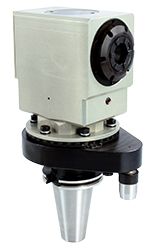 Standard Right Angle Heads - Ideal for milling, drilling, and tapping, they are designed for greater rigidity due to a submerged ER collet bore, and they have spiral bevel gears for higher cutting torque capabilities. They are capable of full 360° body rotation, and are compatible with most automatic tool changers (ATCs).
Standard Right Angle Heads - Ideal for milling, drilling, and tapping, they are designed for greater rigidity due to a submerged ER collet bore, and they have spiral bevel gears for higher cutting torque capabilities. They are capable of full 360° body rotation, and are compatible with most automatic tool changers (ATCs).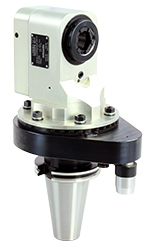 Offset Type Right Angle Heads - They provide additional clearance and rigidity by minimizing the distance between the spindle centerline to the face of the collet nut. They are designed with a submerged ER collet bore for greater rigidity, and spiral bevel gears for higher torque capabilities. They are capable of full 360° body rotation, and are compatible with most automatic tool changers (ATCs).
Offset Type Right Angle Heads - They provide additional clearance and rigidity by minimizing the distance between the spindle centerline to the face of the collet nut. They are designed with a submerged ER collet bore for greater rigidity, and spiral bevel gears for higher torque capabilities. They are capable of full 360° body rotation, and are compatible with most automatic tool changers (ATCs).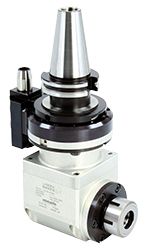 High Torque 40 Taper Right Angle Heads – Higher torque allows for faster material removal resulting in greater productivity. They have full 360° body rotation with positive compression locking, and are compatible with most automatic tool changers (ATCs).
High Torque 40 Taper Right Angle Heads – Higher torque allows for faster material removal resulting in greater productivity. They have full 360° body rotation with positive compression locking, and are compatible with most automatic tool changers (ATCs).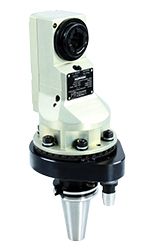 Slim Type Right Angle Heads - Ideal for machining operations in tight quarters, they are designed for rigidity due to a submerged ER collet bore and have spiral bevel gears for higher torque capabilities. They have full 360° body rotation, and are compatible with most automatic tool changers (ATCs).
Slim Type Right Angle Heads - Ideal for machining operations in tight quarters, they are designed for rigidity due to a submerged ER collet bore and have spiral bevel gears for higher torque capabilities. They have full 360° body rotation, and are compatible with most automatic tool changers (ATCs).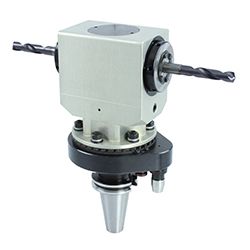 Twin Spindle Angle Heads - They are capable of performing machining operations in opposite directions with one right angle head, and they have full 360° body rotation.
Twin Spindle Angle Heads - They are capable of performing machining operations in opposite directions with one right angle head, and they have full 360° body rotation.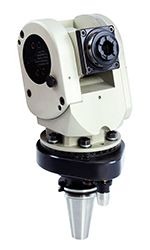 Universal Flexheads – Internal Coolant - Designed for 0-98° angle positioning with precise vernier alignment, they have full 360° body rotation and are compatible with most automatic tool changers (ATCs).
Universal Flexheads – Internal Coolant - Designed for 0-98° angle positioning with precise vernier alignment, they have full 360° body rotation and are compatible with most automatic tool changers (ATCs).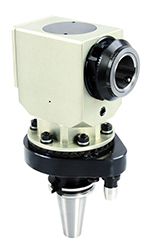 Quick Change Right Angle Heads – Ideal for milling, drilling, and tapping applications, they are designed for rigidity due to submerged ER collet bore and have spiral bevel gears for higher cutting torque capabilities. They have full 360° body rotation, and are compatible with most automatic tool changers (ATCs).
Quick Change Right Angle Heads – Ideal for milling, drilling, and tapping applications, they are designed for rigidity due to submerged ER collet bore and have spiral bevel gears for higher cutting torque capabilities. They have full 360° body rotation, and are compatible with most automatic tool changers (ATCs).
- Angle Head Specials:
 Fixed Angle Heads - Fixed angle heads ensure an accurate angle without the need to adjust or verify the cutting angle. Ideal for families of parts with a common fixed angle, or for high production where optimized rigidity is required to reduce cycle times.
Fixed Angle Heads - Fixed angle heads ensure an accurate angle without the need to adjust or verify the cutting angle. Ideal for families of parts with a common fixed angle, or for high production where optimized rigidity is required to reduce cycle times.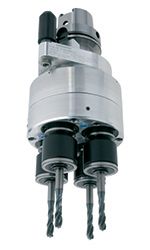 Multi-Spindle Drill Heads - Ideal for high production operations where drilling speed and accuracy must be optimized. Lyndex-Nikken multi spindle units can be designed for all materials, multiple drill sizes, and a varying number of output spindles to match your application.
Multi-Spindle Drill Heads - Ideal for high production operations where drilling speed and accuracy must be optimized. Lyndex-Nikken multi spindle units can be designed for all materials, multiple drill sizes, and a varying number of output spindles to match your application.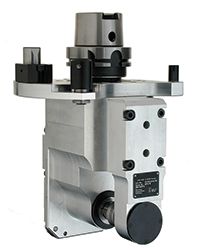 Special Angle Heads - From gear hobbing, deep bore milling, high torque shell mill angle heads, to high speed spindle multiplier angle heads, we have your applications covered.
Special Angle Heads - From gear hobbing, deep bore milling, high torque shell mill angle heads, to high speed spindle multiplier angle heads, we have your applications covered.
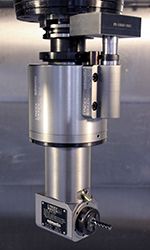 Modular Angle Head System – Flexible for any application and adaptable with a wide variety of machine tapers, modular angle heads are a cost effective solution when angle heads are required on machines with different tapers. Added rigidity is achieved with a bolt style mounting system between taper and modular attachment. The modular angle head system is constructed of:
Modular Angle Head System – Flexible for any application and adaptable with a wide variety of machine tapers, modular angle heads are a cost effective solution when angle heads are required on machines with different tapers. Added rigidity is achieved with a bolt style mounting system between taper and modular attachment. The modular angle head system is constructed of:- Taper
- Positioning pin
- Angle head
Modular attachments come in slim styles for inner bore work, stubby styles for added milling rigidity, extended length styles for added reach, quick change systems for operations involving multiple tools, double output styles to eliminate the necessity for two heads, and a NSK output for small internal engraving and light duty drilling.
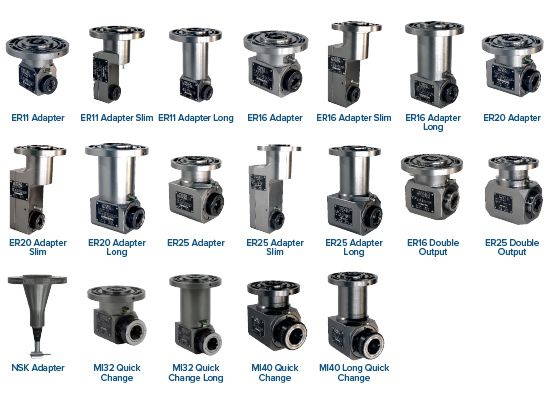
Constructing a modular angle head is easily done in 3 easy steps:

Speed Increasers – High Speed, Small Tool Finish Milling, Drilling & Engraving
Machines have a limited RPM range. So, in cases where a small cutter must be used for machining operations, the spindle RPM must be increased to meet the proper cutting speed for the material being machined.
In other cases, a higher RPM can also translate to faster feeds, allowing for a faster rate of production.
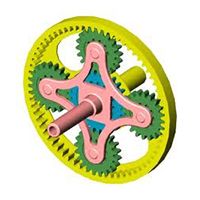
In either scenario, the way to increase a machine’s RPM is by using a speed increaser that uses an epicyclic or planetary gearing system to operate. Since the outer bigger gear has 5 times as many teeth when compared to 1 smaller “planet” gear, for every one rotation of the outer gear, each planet gear will rotate 5 times. In the case where the inside “sun” gear has an equal number of teeth as the planet gear, the center spindle will rotate at 5X times the RPM of the outer bigger gear.
Speed Increaser with the Nikken Advantage
Nikken’s HiSpinner speed increaser is ideal for all high speed, small tool milling and drilling applications. With a gear ratio of 1:5 (1 X input RPM: 5 X output RPM), the maximum RPM is 20,000. The HiSpinner has double the gripping force compared to traditional ER systems due to Nikken’s patented SK collet chucks and TiN bearing nut, As a result, the HiSpinner achieves accuracy of 5-micron runout at 4x the diameter. Additionally, it is lightweight, easy to use, and is capable of working in most automatic tool changers (ATCs).
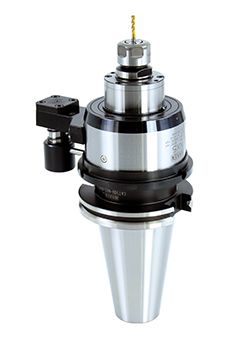
Excellent accuracy and durability are achieved through the use of our integral shank spindle, tempered and ground gears, and high precision pre-loaded spindle bearings.
Highly Accurate - A main spindle supported at four points by high precision (P4 grade) bearings, ensure smooth, precise rotation and increased surface finish quality.
Durable - HiSpinner bearings and gear chamber are isolated from contamination by specially designed seals.
Positioning Pins – Speed increasers that rotate beyond the main spindle’s maximum RPM require a positioning pin to operate. This pin, which is seated into a positioning block, locks the toolholder’s body into a stationary position relative to the spindle face. With its body properly aligned and secured, the toolholder’s internal mechanisms are ready to perform their designed operations. A positioning block may require slight modifications to accommodate your particular machine. Please contact Lyndex-Nikken for additional support to help design the positioning block for your machine.
Videos: Why Manufacturers Choose Lyndex-Nikken Toolholders
Hear and see for yourself how Lyndex-Nikken quality toolholders provide optimal machining solutions for:
